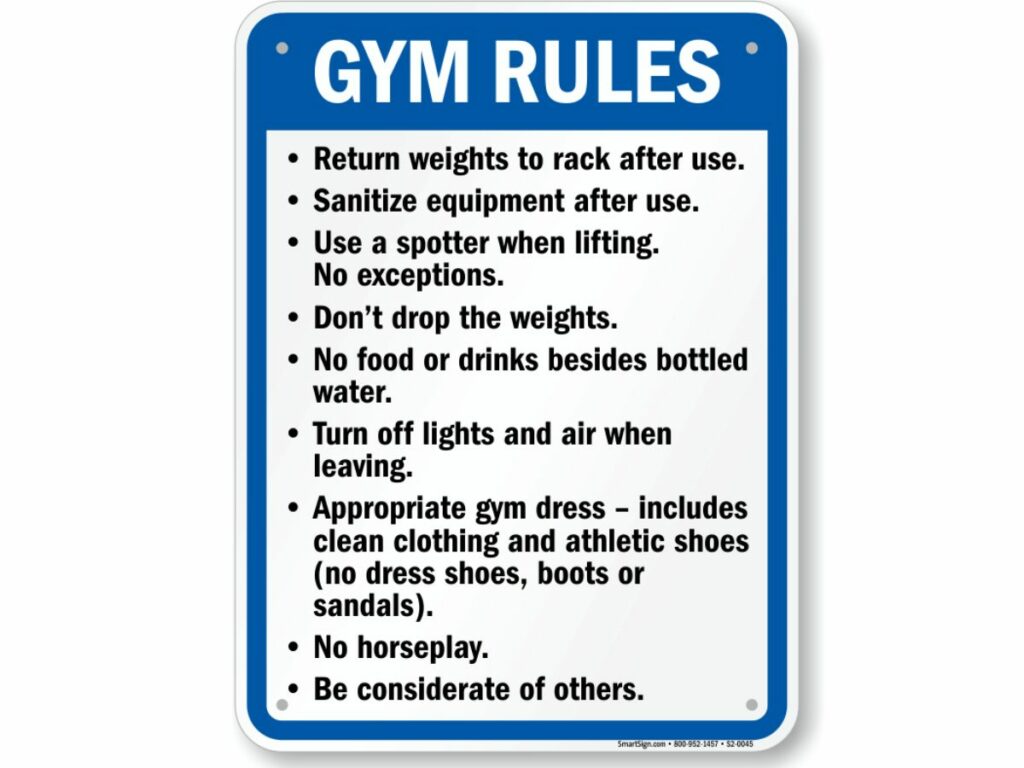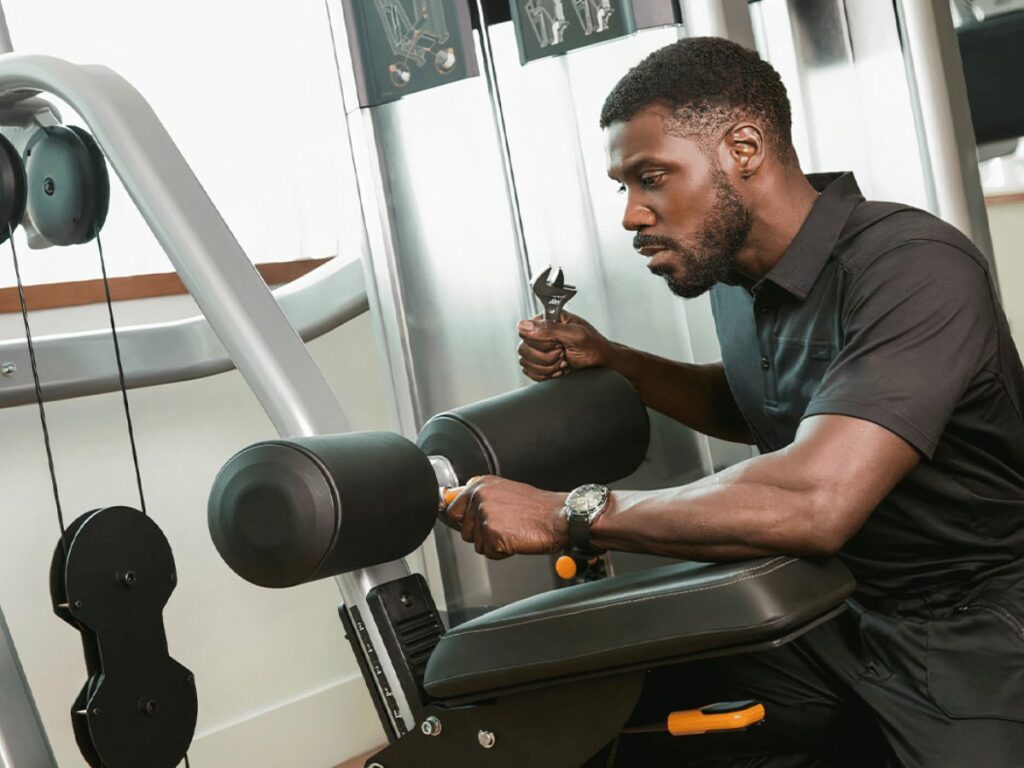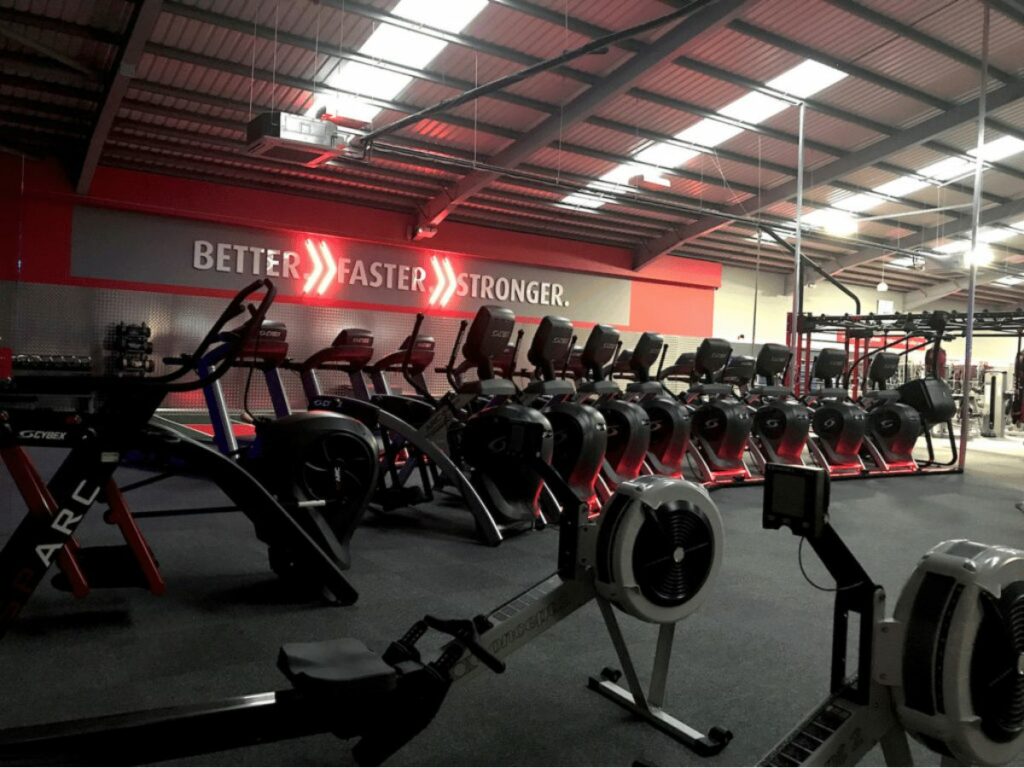Ever wondered what it takes to successfully run a gym in this competitive fitness landscape? The challenges are numerous. So, what exactly does a gym manager’s job entail? It’s an amalgamation of diverse roles, each essential to the smooth functioning and profitability of the gym.
This comprehensive guide will dissect each aspect of the gym manager job description, providing valuable insights that will help streamline operations and promote success in your fitness venture.
Read on to delve into the labyrinth of gym management and emerge with a clear path forward.
Table of Contents
1. Facility Operations Management
The backbone of successful gym operations lies in effective facility management. This involves a multifaceted approach, and here are the integral components:
Health and Safety Regulations
A gym manager must ensure strict compliance with health and safety regulations. This extends beyond the basics of keeping facilities clean and sanitary. It includes the implementation of comprehensive standard operating procedures, conducting regular safety audits, and instituting a rigorous program of training for staff to ensure they understand and adhere to health and safety guidelines.

Equipment Maintenance and Repairs
A key part of a gym manager’s role is ensuring the equipment is in top-notch condition. This means implementing a robust system for routine maintenance checks, immediate repairs when required, and strategic replacement of older equipment. Regular inspection and maintenance schedules help keep downtime to a minimum, ensuring that members always have access to the equipment they need.

Cleanliness and Hygiene
An immaculate gym environment is not only appealing to members but also vital for health and safety. For example, gym managers must establish rigorous cleaning protocols, ensure regular deep-cleaning of facilities, and enforce hygiene standards among members and staff. They need to manage waste efficiently and ensure restrooms, locker rooms, and shower areas are always clean.

Facilities Optimization
Space in a gym is a valuable commodity. Gym managers are responsible for optimizing facility layouts for maximum efficiency. They need to balance the placement of equipment, workout areas, and communal spaces to ensure a smooth flow of traffic, accommodate varying peak usage times, and maintain a positive workout atmosphere.

2. Staff Management
Effectively leading a gym staff member is an integral part of the manager’s role. Let’s delve into the key areas of focus:
Hiring and Onboarding
Finding the right people for the right job is essential. Gym managers are responsible for hiring qualified staff, conducting thorough interviews, and managing the onboarding process. This includes organizing comprehensive training programs to equip new hires with the necessary skills and knowledge.
Scheduling and Conflict Resolution
Scheduling staff to ensure smooth operations at all times is a critical task for gym managers. They need to anticipate peak times and staff vacations to avoid potential issues. Conflict resolution, whether between staff or between staff and members, is another critical responsibility that requires strong leadership and effective communication skills.
Performance Evaluation and Feedback
Gym managers are responsible for evaluating staff performance, providing constructive feedback, and identifying areas for improvement. Regular staff meetings and one-on-one sessions are tools for maintaining open lines of communication and ensuring a high level of job satisfaction among staff.
Staff Development
Investing in staff development is key for maintaining a motivated and skilled workforce. Gym managers should organize regular training sessions, workshops, and courses to keep staff updated on industry trends, improve their skills, and provide opportunities for career progression.
3. Financial Management
Financial acumen is a fundamental requirement for a gym manager. Here are some pivotal areas that need attention:
Budgeting and Cost Control
Gym managers must develop and manage budgets that encompass every aspect of gym operations. This involves anticipating revenue and costs, identifying areas for potential savings, and managing expenditures effectively. Cost control is a critical aspect, with managers often required to strike a delicate balance between ensuring high-quality services and minimizing expenses.
Revenue Generation
A significant aspect of financial management is the ability to drive revenue generation. This involves creating profitable pricing strategies, identifying new revenue streams such as offering specialized classes or selling gym merchandise, and implementing effective strategies to maximize member retention and recruitment.
Financial Reporting and Analysis
Preparing regular financial reports and conducting detailed financial analyses form an integral part of a gym manager’s duties. These activities help track the financial health of the gym, identify trends, and guide strategic decision-making. Managers need to monitor key performance indicators (KPIs) and metrics, such as profit margins, member churn rates, and average revenue per member.
Cash Flow Management
Maintaining a healthy cash flow is vital for the smooth operation of any gym. Gym managers must ensure that the gym can cover its operational costs, including salaries, maintenance, utilities, and other overheads. They must manage cash flow by ensuring prompt collection of membership fees, managing debt, and making timely payments to vendors and suppliers.
4. Membership Sales and Retention
The engine that keeps a gym running is its membership base. A gym manager’s role is central to attracting new members and retaining the existing ones. Here are several key subtopics that demand careful attention:
Sales Techniques and Strategies
One of the primary responsibilities of a gym manager is to attract and onboard new members. This requires the development and implementation of robust sales techniques and strategies. These strategies could vary from offering free trial periods and group discounts to building partnerships with local businesses for promotional purposes.
Member Retention
Believe me, retaining existing members is often more cost-effective than acquiring new ones. Effective member retention strategies may include creating a welcoming and inclusive gym environment, providing exceptional customer service, and consistently improving the facilities and services. It also requires tracking member engagement, and proactively reaching out to them with incentives and solutions to their concerns.
Membership Renewals
The process of membership renewals is another critical area in managing a gym. It’s essential to communicate with members well before their membership expires, making the renewal process as seamless as possible. Managing renewals also means addressing any concerns or issues that might prevent a member from renewing and providing solutions that encourage them to stay.
Member Communication and Engagement
Gym managers must ensure open and effective communication channels with the members. Regular newsletters, social media interactions, personalized emails, and member-only events are effective ways to keep members engaged and informed. This regular engagement not only helps build a stronger sense of community but also enables managers to stay ahead of potential issues and address them proactively.
5. Sales and Marketing
As a gym manager, one must adopt a strategic approach to selling the gym’s services and effectively marketing them to the right audience. Let’s dive into the essential components of this…
Strategic Marketing Plan
A strategic marketing plan is the road map to a gym’s success. For instance, this should involve an in-depth understanding of the target market, a competitive analysis, and the development of unique selling propositions. Managers should craft and execute marketing strategies that leverage both online and offline channels, such as social media, email marketing, print ads, and community events.
Sales Tactics
Effective sales tactics are integral to achieving revenue goals. Gym managers must be skilled in consultative selling – understanding a potential member’s needs and demonstrating how the gym can meet those needs. This requires training the sales team to communicate effectively, address objections, and close sales. It also involves tracking sales metrics and refining tactics based on results and market trends.
Partnerships and Collaborations
Establishing partnerships with local businesses or influencers can be a highly effective marketing strategy. These collaborations can lead to cross-promotion, where both partners can leverage each other’s customer base for mutual benefit. This can include hosting joint events, offering reciprocal discounts, or co-branding campaigns.
Digital Marketing
In today’s digital age, effective online marketing can significantly boost a gym’s visibility and member acquisition. This can involve optimizing the gym’s website for search engine optimization (SEO), using social media platforms to engage with members and prospects, running online ad campaigns, and harnessing the power of email marketing to maintain regular contact with members and leads.
6. Reporting and Analysis
According to Data Pine, data based decision making will propel your business to new heights. Gym managers need to leverage various data points to guide their strategies. Let’s explore these aspects in more detail:
Data Collection and Management
Accurate and efficient data collection forms the foundation of any analytical endeavor. Gym managers must ensure the collection of relevant data – from member sign-ups, usage patterns, and feedback to financials and marketing metrics. This also involves using appropriate data management systems to store and organize this information effectively.
Performance Reporting
Creating regular performance reports is crucial for monitoring the gym’s progress and making informed decisions. These reports should track various metrics, such as member acquisition and retention rates, financial performance, and staff productivity. They provide a snapshot of the gym’s current performance and help identify areas needing improvement.
Data Analysis and Insights
Analyzing the collected data can reveal patterns, trends, and insights that can guide strategic decision-making. This involves not just crunching numbers, but interpreting them in the context of the gym’s goals and the broader market environment. It requires a comprehensive understanding of analytical methods and the ability to translate findings into actionable strategies.
Forecasting and Predictive Analysis
By studying past trends and using statistical models, gym managers can forecast future outcomes – from member growth and revenue to equipment needs and staffing requirements. Predictive analysis can help identify opportunities and challenges well in advance, enabling proactive decision-making and strategic planning.
7. Equipment Procurement
The process of equipment procurement is a vital part of gym management, requiring strategic thinking and careful planning. Let’s explore some key components of this:
Equipment Selection
Choosing the right equipment for a gym involves considering a wide range of factors. Gym managers must understand their members’ fitness goals and preferences to ensure the gym offers the most suitable mix of cardio, strength training, and functional training equipment. High-quality equipment from reputable manufacturers, like Yanre Fitness, ensures durability, superior performance, and longevity.
Vendor Negotiation
Strong negotiation skills can make a significant difference in the cost of gym equipment. Trust me, gym managers should be adept at communicating with suppliers, understanding the terms of warranties, negotiating prices, and securing favorable payment terms. They need to establish strong relationships with reputable suppliers and leverage these relationships to get the best deals.
Equipment Layout and Design
The placement of equipment within a gym can impact members’ workout experience. Gym managers need to design a layout that optimizes space, promotes safety, and facilitates a smooth flow of traffic. They must ensure that there is enough space around each equipment for members to exercise comfortably and safely.
Equipment Maintenance and Replacement
Regular maintenance of gym equipment prolongs its lifespan, ensures safety, and enhances the member experience. Gym managers must implement effective maintenance schedules and ensure that any repairs are carried out promptly. Collaborating with trusted manufacturers, such as Yanre Fitness, can ease this process, ensuring a long-lasting, high-quality fitness experience for members.
8. Performance Evaluation
Regular performance evaluations help ensure that a gym meets its objectives and maintains high standards. Here are the critical elements of this process:
Staff Performance Appraisals
Regular evaluation of staff performance is crucial to ensure they meet their job requirements and contribute positively to the gym’s environment. Gym managers must establish clear performance criteria, provide constructive feedback, and work with staff to develop improvement plans as needed. Based on my experience, these appraisals also provide an opportunity to recognize and reward outstanding performance.
Member Satisfaction Surveys
Feedback from members is invaluable for assessing the gym’s performance from a customer’s perspective. For instance, gym managers should regularly conduct member satisfaction surveys to gather opinions on various aspects of the gym, from equipment and facilities to classes and customer service. This feedback can help identify strengths and areas for improvement.
Financial Performance Analysis
Assessing the gym’s financial performance against set goals and industry benchmarks is essential for ensuring its profitability and sustainability. Gym managers should analyze financial reports to understand revenue trends, control costs, and make strategic decisions about pricing, investments, and cost-cutting.
9. Professional Development and Industry Knowledge
A successful gym manager needs to commit to lifelong learning and industry awareness. Let’s explore these aspects further…
Training and Certification
Even seasoned gym managers can benefit from ongoing professional training and obtaining industry-relevant certifications. Such certifications can range from advanced fitness training and nutrition to business management and customer service. Regular training can help managers stay up-to-date with the latest industry practices and enhance their professional credibility.
Fitness Trends and Innovations
According to Glofox, the fitness industry is always evolving and changing. From the latest workout techniques and equipment to digital fitness platforms and wearable technology, gym managers need to keep a finger on the pulse of these changes. By staying informed about new trends, managers can make timely decisions about introducing new classes, equipment, or digital solutions to meet members’ evolving needs. This table provides an overview of current fitness trends and innovations, ranging from workout techniques and equipment to digital platforms and wearable technology, to help gym managers stay informed and adapt to the evolving needs of their members.
| Trend/Innovation | Description |
| High-Intensity Interval Training (HIIT) | HIIT involves short bursts of intense exercise followed by brief recovery periods. It has gained popularity due to its time efficiency and ability to improve cardiovascular fitness and burn calories. |
| Wearable Fitness Technology | Wearable devices like fitness trackers, smartwatches, and heart rate monitors allow users to track their activity levels, heart rate, sleep patterns, and more. They provide real-time feedback and help individuals stay motivated and monitor their progress. |
| Virtual Fitness Classes | With the rise of digital platforms, virtual fitness classes have become increasingly popular. These classes offer convenience and flexibility, allowing users to participate from anywhere with an internet connection. They often include live or pre-recorded workouts with professional instructors. |
| Functional Training | Functional training focuses on movements that mimic everyday activities to improve strength, balance, and coordination. It often utilizes equipment like stability balls, resistance bands, and kettlebells to engage multiple muscle groups simultaneously. |
| Mind-Body Exercise | Practices like yoga, Pilates, and tai chi emphasize the connection between the mind and body. These exercises promote flexibility, core strength, balance, and stress reduction through controlled movements, breathing techniques, and mindfulness. |
| Group Training | Group training classes, such as indoor cycling, boot camps, and circuit training, provide a motivating and social environment for participants. They encourage camaraderie, accountability, and healthy competition while delivering a structured workout. |
| Recovery and Regeneration Tools | Various tools like foam rollers, massage guns, and compression boots aid in muscle recovery and reduce muscle soreness. These tools help increase blood flow, decrease inflammation, and enhance mobility and flexibility. |
| Online Coaching and Personal Training | Online coaching and personal training have become more prevalent, allowing individuals to receive personalized guidance, workout plans, and nutritional advice remotely. Virtual sessions and communication platforms make it easier to connect with fitness professionals. |
| Functional Fitness Equipment | Innovative fitness equipment like battle ropes, TRX suspension trainers, and slam balls provide versatile options for functional training workouts. These tools engage multiple muscle groups and improve stability, strength, and coordination. |
| Mindfulness and Meditation Apps | Mindfulness and meditation apps offer guided sessions for stress reduction, improved focus, and overall mental well-being. They provide individuals with tools to practice mindfulness and develop a meditation routine at their convenience. |
Health and Safety Regulations
Compliance with health and safety regulations is crucial in the fitness industry. Gym managers must ensure that their facilities meet all relevant regulatory standards, from equipment safety and cleanliness to staff certifications and emergency procedures. Keeping up-to-date with changes in these regulations is essential to avoid compliance issues and ensure member safety.
Networking and Industry Events
Participation in industry events and professional networking can provide valuable learning opportunities and insights. Gym managers can benefit from attending fitness expos, webinars, seminars, and industry meet-ups. Networking can also help establish beneficial partnerships, learn from industry peers, and gain exposure to new ideas and practices.
10. Conclusion
So, to wrap things up about Gym Managers: they’re the heart of any fitness establishment, responsible for planning programs, supervising staff, and ensuring safety. Their role is crucial for a successful and thriving fitness business.
Now, let’s talk about taking your gym to the next level with Yanre Fitness. We’ve got the top-notch equipment businesses need to create a fantastic workout experience. Why not get in touch with us for more product details, a catalog, or even a price list? Let us be your go-to partner in building the ultimate fitness space. Contact us today, and let’s make it happen together!
Related articles:








